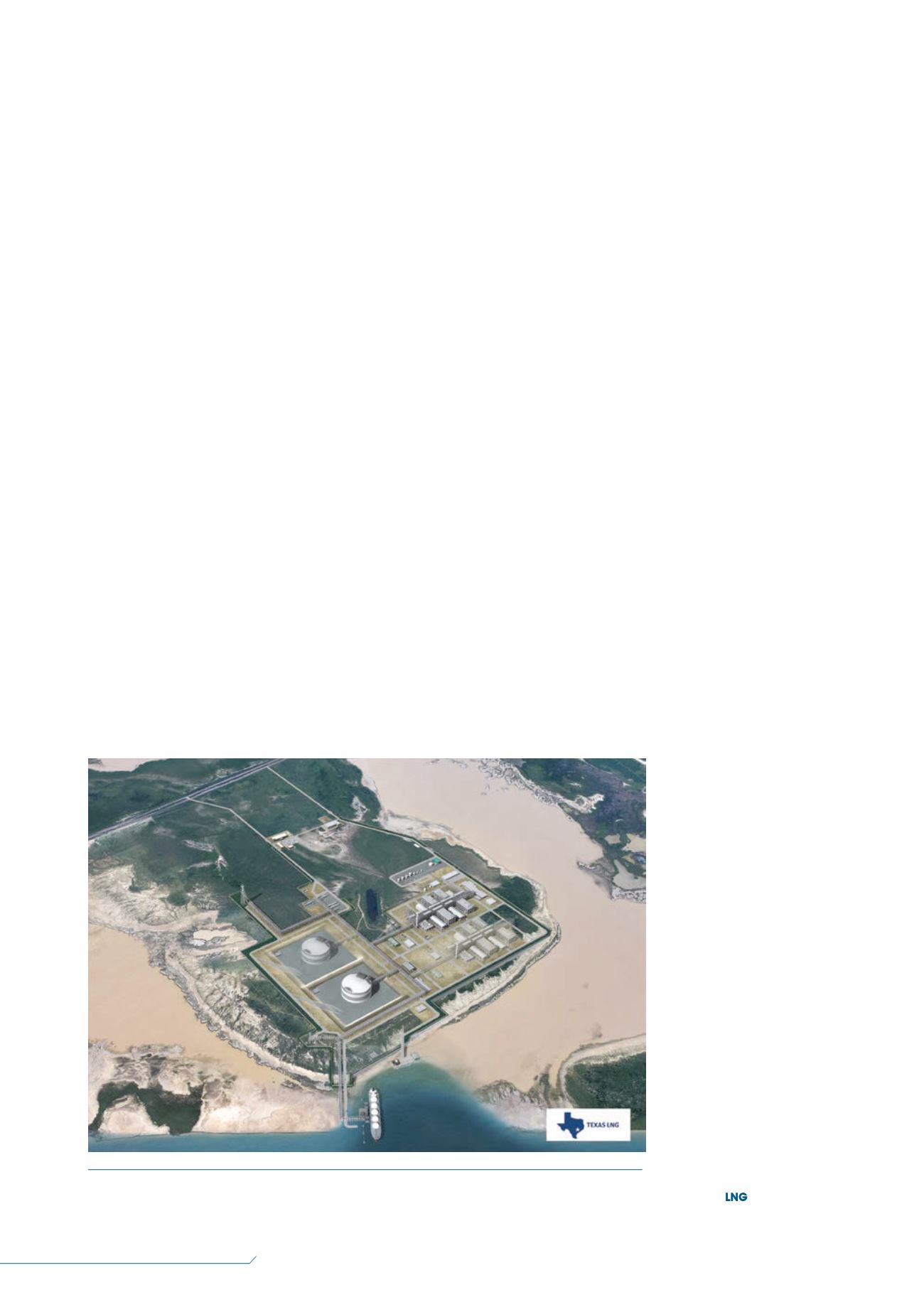
56
LNG
INDUSTRY
MARCH
2016
long-run. If gas prices do rise above the sub US$2/million Btu
levels seen today, Texas LNG’s delivered costs will not rise in
the same proportion as a similar percentage increase in oil
price. This is because oil-linked LNG formulae multiply the
price of oil by a factor relating oil and gas prices (commonly
referred to as the ‘slope’). In the case of Texas LNG, there is,
of course, no relation to oil prices in the formula, and the
relationship to US feed gas prices is a ‘cost-plus’ formula, not
a multiplier. When US feed gas prices rise, Texas LNG’s
delivered LNG prices will rise by the same dollar amount, not
in the same proportion. This is illustrated in Figure 1.
Facility
The Texas LNG site is located on the Brownsville ship channel
– a wide, deepwater channel, approximately 5 nautical miles
from open sea. LNG carriers of up to 170 000 – 180 000 m
3
cargo capacity will be able to dock at the Texas LNG terminal
jetty, allowing for maximum flexibility in the transportation of
LNG from the terminal. The site is close to major natural gas
pipelines and the Eagle Ford basin – one of the major shale
gas basins in the US. Gas can also be sourced from other
suppliers through the elaborate US natural gas pipeline grid.
Texas LNG is a 4 million tpy LNG production facility to be
implemented in two phases of 2 million tpy each. The on-site
construction cost will be minimised by adopting a modular
construction approach. The modules for the LNG plant will be
assembled in global shipyards, taking full advantage of the
low prices currently quoted by shipyards due to rapidly
shrinking order backlogs and order cancellations for ships and
offshore rigs. Train 1 will have a single LNG storage tank,
currently planned to be 210 000 m
3
, which will be large
enough to fully load the largest LNG carriers able to call at the
terminal. The environmental impact is reduced by the small
size of the LNG production facilities relative to the site and the
use of grid electrical power (rather than on-site gas
consumption or electricity generation), which will also be
beneficial for the FERC approval process.
Founders and partners
Texas LNG was founded in 2013 by three experienced
energy executives: Vivek Chandra, Chief Executive Officer;
Langtry Meyer, Chief Operating Officer; and Mike Maloney,
Chief Technology Officer.
Samsung Engineering of South Korea is a minority equity
partner in the project and is responsible for FEED and
engineering, procurement and construction (EPC). Samsung
will execute the EPC on a lump sum basis, thus minimising
the risk of budget overruns for the developers and their
financial backers.
Braemar Engineering has been engaged by Texas LNG to
act as owner’s engineer, overseeing the design process and
leading the FERC filing process.
Third Point LLC, a New York based investment fund with
approximately US$17 billion in assets under management, has
taken an equity interest in the Texas LNG project and has
provided development capital for the project.
Project schedule
The development of the Texas LNG project is progressing
on schedule and all major milestones have been achieved
on time. The conceptual design, pre-FEED and FEED have
been completed, and the detailed engineering works will
begin shortly. The FERC pre-filing process is underway and
all 13 draft Resource Reports were filed in 2015. The main
engineering report, Resource Report 13, was submitted in late
September 2015. The EPC phase is scheduled to start in 2017,
with start-up of LNG production scheduled for 2020.
In June 2014, the company was granted approval to
export 2 million tpy of LNG to countries that hold a Free
Trade Agreement (FTA) with the US. Approval to export
4 million tpy to FTA countries
followed in September 2015.
The project’s non-FTA export
approval is pending.
Conclusion
The realistic capacity
target, the use of low cost
US feed gas and the low
cost modular construction
philosophy to keep overall
CAPEX down, as well as its
strategic location for exports
to emerging markets in
the Americas and Europe,
will make Texas LNG
commercially viable in
a changing market. The
use of proven technology
in liquefaction and LNG
storage will create a low
risk investment opportunity
for the project’s financial
backers and provide security
of supply for the LNG
offtakers.
Figure 2.
Texas LNG’s 625 acre site along the Brownsville Ship Channel, 5 nautical miles from the
Gulf of Mexico.


